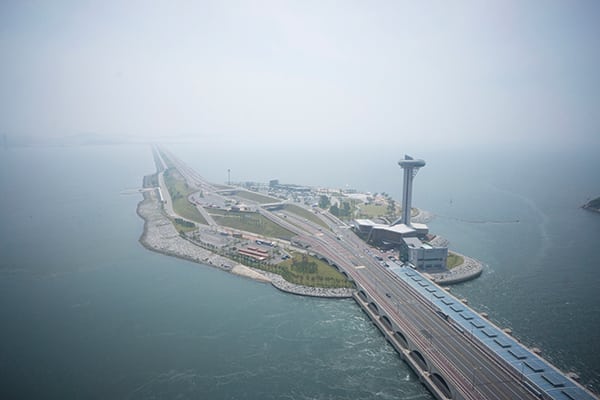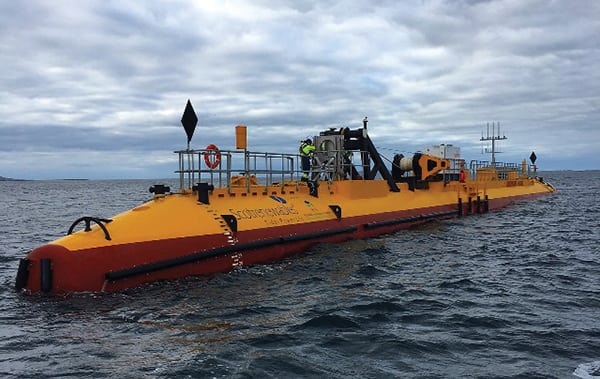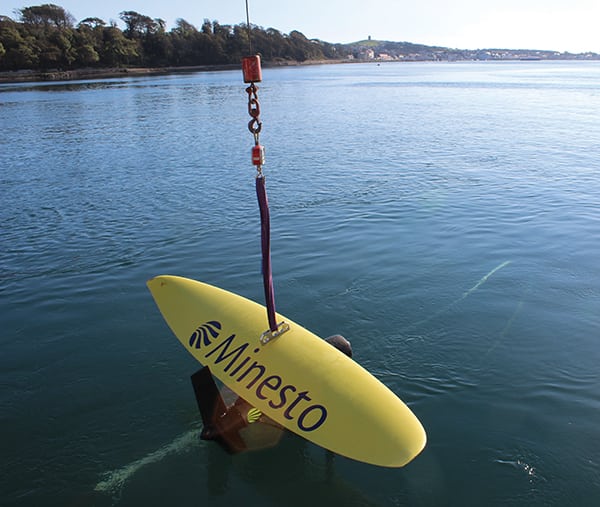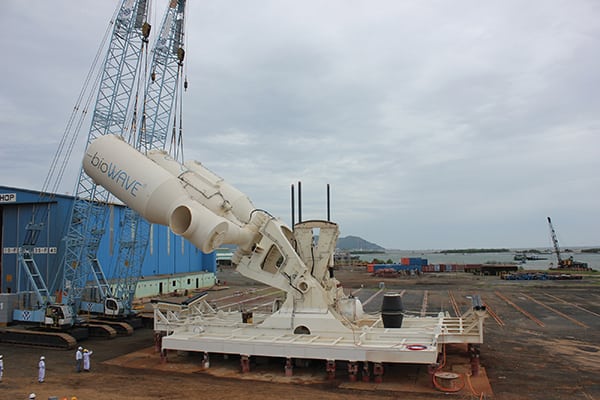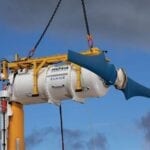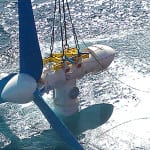The ocean power sector is still in its early stages of development, shackled by high development and operational costs. Trends emerging over the past two years hint at which technologies could dominate the sector’s future.
Despite decades of research and development that have yielded several innovative ways of using oceans to fuel power generation, the contribution of ocean energy to the global energy mix has stalled at about 530 MW, most of it installed in 1966 and 2011.
According to the International Renewable Energy Agency (IRENA), the widespread adoption of technologies that seek to harvest power from ocean surface waves, tidal currents, deep ocean currents, thermal gradients, and changes in salinity continues to be hampered by a number of crippling factors. Ocean energy converters are characterized by a number of technology variants that are defined largely by the ocean resource that they seek to harness. But these variants typically have their own design issues, are at different stages of operation and commercial maturity, and have unique environmental issues. Largely due to the common challenge of working in an offshore environment, most technologies suffer similar soaring levelized costs. Worse, IRENA notes, is that these costs are hard to predict, owing to limited available empirical cost data, wide variability in project cost strategies, and limited understanding of key costs of energy drivers such as capacity factor and design life. That creates much uncertainty for developers looking to deliver utility-scale, bankable projects.
However, that may be poised to change. The adoption of the first-ever universal legally binding global climate deal by 195 countries as a result of the Paris climate conference in December 2015 may offer more sustenance for the fledgling sector. At least 147 countries mentioned renewable energy boosts in their submitted Intended Nationally Determined Contributions. IRENA also suggests that the global drive for decarbonization and electric reliability highlights several opportunities and benefits proffered by ocean energy technologies over other renewables, including improved predictability, decreased variability, spatial concentration, and socio-economic benefits.
So far, only a handful of countries have set ambitious targets for ocean power (Table 1). However, as IRENA notes, patents for ocean power technologies have been filed around the globe, with “hotspots” in the UK, France, U.S., Canada, Japan, South Korea, and Australia. These filings—along with prototype deployments, sea trials, and new developments during 2015 and 2016—highlight trends within the sector that are notable, showing the direction in which ocean power’s future could flow over the next few years.
 |
|
Table 1. Existing targets for ocean power. Source: REN 21 Global Status Report 2016 |
Tidal Barrages: Rare but Conventional
Almost all commercial ocean power projects installed to date globally are tidal barrage projects (also called tidal range projects), which take advantage of the vertical difference in height between high tide and low tide, generating power as the tide floods into and out of a constructed reservoir. They include Electricité de France’s (EDF’s) 240-MW La Rance station in Brittany, a 750-meter (m)-long barrage with 24 turbines that began operating in November 1966.
Following La Rance were the 20-MW Annapolis Tidal Power Plant that Nova Scotia Power opened in 1984 to harness the large tides in a sub-basin of Canada’s Bay of Fundy, and the Jiangxia barrage in China’s Zhejiang Province, which, when completed in 1985, had an installed capacity of 3.2 MW (a sixth turbine added in 2006 boosted capacity to 3.9 MW, and in 2015 the project was upgraded to 4.1 MW). La Rance reigned as the largest tidal barrage for nearly 45 years, until the 254-MW Sihwa Lake project (a December 2015 POWER Top Plant) came online in South Korea in 2011 (Figure 1).
Bigger barrages have since been proposed, notably, the 320-MW Swansea Bay Tidal Lagoon in Wales, which received the UK’s planning consent in June 2015. In February 2016, however, the UK said it would review the feasibility and practicality of tidal lagoon power, specifically to vet its cost-effectiveness, potential environmental impacts, and financing options.
According to IRENA, “the fact that there has only been a single large project since the technology was first commercially operated in the 1960s illustrates that the tidal range technology is not drawing as much serious developmental interest as the other emerging, pre-commercial ocean energy technologies.”
Tidal Stream: Coasting on the Current
For IRENA, the technology that appears the most promising—based on global interest and prototype deployment—seeks to extract power from tidal streams, or the flow of water as the tide ebbs and floods and manifests itself as tidal current. Over the past five years, nearly all tidal stream deployments had been single-machine prototype tests, often at test centers such as the European Marine Energy Centre (EMEC) in the Orkney Islands in Scotland. IRENA also notes that most leading tidal stream developers are currently pursuing seabed-mounted, horizontal-axis, axial-flow turbines.
During 2015 and 2016, this sector saw a burst of activity.
Tidal Stream Devices and Arrays. The 6-MW MeyGen tidal stream array marked major milestones over the past year as its majority owner Atlantis Resources completed assembly of four 1.5-MW tidal stream turbines (three built by Andritz Hydro Hammerfest and one by Atlantis) that will be installed in the Pentland Firth, a strait that separates the Orkney Islands from Caithness in the far north of Scotland, as part of the demonstration phase. In October 2016, Scottish engineering firm Scotrenewables Tidal Power installed its 2-MW SR2000 floating turbine—the world’s most powerful to date—on its moorings at EMEC as part of site commissioning and testing (Figure 2).
In mid-2016, Nova Innovation and its Belgian partner delivered power to the grid from the first two of three 100-kW M100 direct-drive turbines planned for installation in Scotland’s Bluemull Sound, claiming it was the world’s first commercial grid-connected tidal array.
In France, DCNS subsidiary OpenHydro followed suit, deploying the first of two new turbines at EDF’s Paimpol-Bréhat site. Sabella SAS in July 2016, meanwhile, retrieved a full-scale grid-connected 1-MW D10 tidal turbine after a 12-month-long test that had it submerged off the coast of Brittany.
Wales saw its own historic grid connection of a 400-kW DeltaStream tidal stream device developed by Cardiff-based Tidal Energy in Ramsey Sound, Pembrokeshire. The device has a gravity-based foundation that will sit on the seabed under its own weight, eliminating the need to drill or pile the 200-metric-ton, 18-m-tall structure to the seabed.
And in February 2015, Dutch tidal power firm Tocardo installed three grid-connected T1 tidal turbines (a total 300 kW) in a Dutch sea defense dike in cooperation with the Dutch Tidal Testing Center. Later, in September 2015, it installed five T2 turbines (1.2 MW) in the Dutch Eastern Scheldt storm surge barrier.
Floating Platforms. In October 2015, Tocardo also announced that it was successfully operating a grid-connected (with cables) floating tidal energy platform (developed as part of the BlueTEC Texel Tidal partnership) that was outfitted with a T2 turbine. And in June 2016, Sustainable Marine Energy successfully installed four subsea drilled rock anchors at its berth at EMEC, despite challenging tidal flows. The achievement is a “world-first,” it said. The anchors will now be used to moor its PLAT-O tidal energy platform, which is outfitted with two Schottel instream turbines.
Tidal Kite. Although there is no lack of novel prototype concepts, one stands out for its government backing. This year, Swedish firm Minesto prepared to deploy a full-scale Deep Green “tidal kite” device (Figure 3) in Wales by summer 2017, securing funding from the Swedish Energy Agency and the European Union.
Wave Power: Oscillating Opportunities
The wave power sector has seen a relatively stagnant period since Pelamis Wave Power made history in 2008, when the world’s first commercial 2.25-MW wave energy farm using the company’s snakelike wave energy convertors was grid-connected off the Aguçadoura coast in Portugal. Over the past two years, however, the global wave power sector has seen significant crests and troughs.
In November 2014, Pelamis went into administration after being unable to secure the level of additional funding required for continued development of its technology. And while UK firm Aquamarine Power made headlines in early 2015 for a successful demonstration of its Oyster 800 wave energy converter, just a few months later, it too was placed into administration due to a lack of private sector support needed to supplement public funding. The company was later dissolved.
On the technology front, wave energy converters show less design convergence compared to tidal stream technologies, IRENA says. However, it notes that “there is a tendency towards designing floating point absorber systems for offshore applications.”
Among notable milestones is Swedish firm Seabased’s January 2016 connection of 6-m-wide buoys to respective wave energy converters on the seabed at the 1-MW Sotenäs Wave Energy Plant off the Swedish West Coast, making it the world’s first array of multiple wave energy converters in operation. That project also uniquely uses a 120-ton susbsea generator switchgear (which Seabased says is a “world-first”) to connect it to the grid via a 10-km subsea cable.
In Australia, Carnegie Wave Energy (now Carnegie Clean Energy) deployed its 1-MW CETO 6 device in early 2016. And UK firm 40South Energy in November 2015 launched its 50-kW H24 wave energy converter, which is a fully submerged machine designed to convert wave and tidal energy in shallow waters.
Meanwhile, in December 2015, Australian firm BioPower Systems deployed its 250-kW bioWAVE pilot demonstration unit offshore Port Fairy, Victoria. The device, partly funded by the federal Australian government as well as by the state of Victoria, is an oscillating structure inspired by sea plants that is designed to sway back and forth beneath the ocean swell to capture energy. However, this September, bioWAVE announced that inspections had revealed that the subsea cable linking the unit to the grid had been damaged, and repairs are under way (Figure 4).
Ocean Thermal Energy Conversion Makes a Small Gain
Ocean thermal energy conversion (OTEC) exploits the ocean’s thermal gradients—temperature differences of 36 degrees F or more between warm surface water and cold deep seawater—to drive a power-producing cycle. But despite knowledge of the resource and its potential to provide many useful by-products such as freshwater, hydrogen via electrolytic processing of freshwater, and lithium and uranium (which may be extracted from deep seawater), OTEC development has been gradual, primarily because of operational costs.
Nevertheless, since the technology was first proposed as far back as 1881 by a French physicist, several projects have demonstrated the promising technology’s potential. Japanese researchers, fostered by the Ministry of International Trade and Industry, have built several pilot plants at Saga University on the island of Kyushu. In 2013, their efforts produced a demonstration project consisting of two 50-kW units that use R134, a refrigerant, as the working fluid. Meanwhile, in 2013, South Korea built a 20-kW pilot plant, with plans to expand it to a 200-kW project.
And, in August 2015, Makai Ocean Engineering connected a 100-kW closed-cycle OTEC plant at the Natural Energy Laboratory of Hawaii Authority to Hawaii’s grid (see “Largest OTEC Facility Inaugurated in Hawaii,” in POWER’s October 2015 issue).
IRENA suggests that interest in OTEC will continue, bolstered by continuing research and development efforts by companies such as DCNS, Lockheed Martin, Makai Ocean Engineering, Bluerise, and others. However, it notes that to achieve the requisite economies of scale, OTEC plants need to be sized at 100 MWe or larger. ■
—Sonal Patel is a POWER associate editor.


